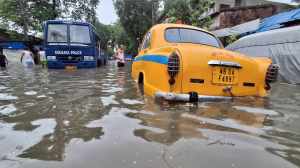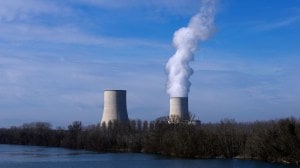In Maharashtra hinterland Terrors new Addresses
Senior state police officers are conscious that Islamic radicalism has spread at an alarming rate in Maharashtra,with an extensive rural network suspected to have been created in the Marathwada region
The probe of the Maharashtra Anti-Terrorism Squad (ATS) into the February 13 blast in Punes Germany Bakery led investigators on a trail across seven states. But the breakthrough eventually came from within the state,with ATS sleuths unearthing a terror base in an obscure part of Marathwada that had previously remained off the radar of security agencies. The discovery has raised concerns in the security establishment as it indicates that radical Islamists may have managed to penetrate the hinterland of the state and set up a network of misguided youngsters to unleash terror in the region.
It was Udgir in Latur district that the Lashkar-e-Toibas alleged Maharashtra chief Mirza Himayat Baig chose as his base of operations on completion of his terror training in Colombo in March 2008. With money received from the LeT,he set up the Global Internet Cafe where the improvised explosive device used in the Pune blast was assembled.
It (Udgir) was actually a brilliant choice,as nobody would have ever suspected in the beginning that the perpetrators of the Pune blast could be based there. Baig could run his operation anonymously from Udgir,and could easily travel to and from Pune and even to Karnataka and Andhra Pradesh, pointed out Additional Director General of Police (ATS) Rakesh Maria.
Besides the remoteness of the terror hideout,the two Lashkar men arrested by the ATS during the probe were not indoctrinated and were recruited from major urban centres in the state. Baig hailed from Beed district and Shaikh Lalbaba Mohammed Hussain Farid alias Bilal,booked for hatching a terror plot targeting government buildings in Nashik,is a native of Hotgi in Solapur.
Previous terror probes such as the 7/11 serial train blasts investigation have usually seen arrests made from predominantly Muslim ghettos in and around Mumbai such as Mira Road,Govandi,Kurla,Cheetah Camp,Malwani or Bhiwandi. These areas are perpetually under the police watch,with combing operations routinely conducted here after any terror operation in the state. In September 2008,the Mumbai Police Crime Branch neutralised a terror base of the Indian Mujahideens media wing led by techie Mansoor Peerbhoy in Punes Kondwa area.
The arrest of Baig and Bilal is indicative of the fact that the active Islamist terror network in Maharashtra is no longer largely confined to the traditional urban terror hotspots identified by security agencies. Senior state police officers are conscious that Islamic radicalism has spread at an alarming rate in Maharashtras hinterland,with an extensive rural network suspected to have been created in the Marathwada region.
There are definite patterns emerging through this (Pune blast) investigation. The role and emergence of the network in Marathwada at large also remains. We have to look at the interlinking patterns as the borders or divides between various Islamic terror groups are blurring. These are youths who can easily travel from place to place. The fact that the group was working in various cities and moving means that they have local support and huge funding, said a senior Maharashtra Home Department official.
Further,Baigs arrest has once again put Maharashtras Beed district under the security scanner. A large number of youths from the district are known to have joined the terror fold and participated in major operations in recent years.
The Marathwada region is a sensitive area,where we suspect several sleeper cells might exist. In the case of Beed specifically,several persons from the area have been recruited,indoctrinated and sent for terror training to Pakistan. Many youths from Beed have either been arrested by the police in connection with terror cases,or have been killed in police encounters. Going back to the BEST bus blast in Ghatkopar in December 2002,Dr Abdul Mateen who was arrested by the Mumbai police also hailed from Beed. After this,there were many arrests made from Beed during the Aurangabad arms haul case, said Additional Director General of Police (Law and Order) and former ATS chief K P Raghuvanshi.
In May 2006,the Maharashtra ATS seized a huge cache of 43 kgs of RDX,16 AK-47 rifles,3,200 live cartridges,62 magazines for the rifles,and 50 hand grenades from Aurangabad and Malegaon,making it one of the largest arms hauls ever in the state. Many of the 21 accused arrested in the case belonged to Beed,as did some of those still wanted by the police.
Sayyed Zabdiuddin Syed Zakiuddin Ansari alias Zabi,a native of Beed who grew up in Hatti Khana,Dhangar Galli in the town of Gevrai,was named as a key Lashkar operative involved in the Aurangabad arms haul case in May 2006. He is also an accused in the Ahmedabad railway station blast in February 2006,and his name has cropped up once again in connection with the Pune blast as one of Baigs handlers.
Another of Baigs handlers and key absconding accused in the Ahmedabad railway station blast and the Aurangabad arms haul case,Zulfikar Fayyaz Ahmed Kagzi,also grew up in a small room near Aaksa Masjid in Firozshah Nagar,New Shahenshah Nagar,in Beed. Two other absconding accused in the Aurangabad case,Shaikh Masood Mehmood Ahmed alias Azhar and Shaikh Ejaz alias Shergil,are also natives of Beed.
We are aware that there has been a great deal of radicalism in Beed it has increased in the last decade or so. There are various events that have caused communal tension in the area,but there are historical factors that have led to the problem as well. The region was initially under the control of the Nizam,and when power changed hands after Independence,it gave rise to a sense of resentment among Muslims living there, said a top state police officer,who did not wish to be named.
On May 15,1986,Beed witnessed communal unrest when several Muslims were killed by Hindus when riots broke out in Umapur. Following that,the area remained quiet until the violence that followed in the wake of the Babri Masjid demolition. After 13 people were killed in riots in Malegaon on October 26,2001,communal disturbance was witnessed in northern Maharashtra,as well as in Marathwada and Vidarbha.
Around this time,tensions were at a high when a statue of Shivaji was found to have been deliberately damaged in Parli,Beed. Subsequent police investigations led to the arrest of Shiv Sena activists who were attempting to spark riots in the area as the municipal and zila parishad elections were due to be held shortly thereafter. Again,the area was tense following the Gujarat riots in 2002.
Javed Anand,general secretary of Muslims for Secular Democracy,reasoned,It may just be that these terrorists have shifted their bases to the hinterland and areas like Beed for purely circumstantial reasons and as a strategy to remain below the radar and to avoid arrest. However,blasts in areas like Parbhani,Jalna,Purna and Nanded had shown that terror networks existed in the Marathwada region. The state police should have investigated these cases thoroughly at that time.
There may have been a backlash of Islamic radicalism and terror recruitment in the region owing to the 2004 blasts by Hindu perpetrators in Jalna,Purna and Parbhani and the accidental blast in Nanded in 2006, added Raghuvanshi.
With inputs from Swatee Kher
Photos


- 01
- 02
- 03
- 04
- 05





























